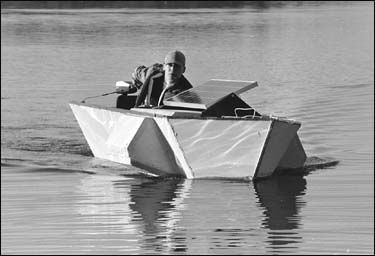 They have tested it in a swimming pool and on Lake Koronis. The Paynesville Principals of Technology class members feel they are ready to enter the solar regatta on May 30 at Island Lake in Shoreview. Registration starts at 9 a.m. with competition starting at 10 a.m.
They have tested it in a swimming pool and on Lake Koronis. The Paynesville Principals of Technology class members feel they are ready to enter the solar regatta on May 30 at Island Lake in Shoreview. Registration starts at 9 a.m. with competition starting at 10 a.m.Paynesville will compete against 19 other student-built solar-powered boats in the contest.
Class members have been busy building from scratch a solar powered boat since January. On its first test run in the Country Inn swimming pool, the boat tipped and sank. The students took the boat back to class and revamped the design so it would be better balanced and stay afloat.
According to Jay Thompson, instructor for the class, the boat weighs about 190 pounds and is made of about 20 pounds of two-inch styrofoam, 25 tubes of glue, and plywood. Two car batteries in the boat amount to about half of the total weight. The solar panel powers car batteries to run the trolling motor. The boat will hold about 600 pounds.
ďWe can hook up to three motors,Ē Thompson added. ďThe winning boat in last yearís contest could travel about 30 miles per hour. Our boat traveled on the test runs about five miles per hour.Ē
ďThe first time we tested the boat, there was still ice on the lake and the pool was a good site for its maiden voyage,Ē Thompson said.
To help balance the boat better, outriggers made of styrofoam, were added to both sides of the boat.
The solar regatta is sponsored by the Minnesota Renewable Energy Society, a volunteer organization which promotes awareness of renewable energy and the Minnesota Technology Education Association.
Teams will compete in speed, maneuverability, endurance, esthetic, and design events. This will be the seventh such regatta.
The boats will measure anywhere from 10 to 20 feet in length. All have electric motors, one or two batteries, and solar panels to convert light to electricity. Hull designs range from canoes to catamarans, some built in school, some bought or borrowed.
There are four events, and boats are encouraged to run in all four. In the speed race, the boats race a designated straightaway in small heats with the fastest time winning. In the endurance run, the boats circle an island for two hours. The boat that runs the most laps wins. In the maneuverability race, each boat slaloms through a course of buoys while trying not to touch them, the nearby shore, or take on water. The fastest time wins. The toughest event is to run without batteries. Powered directly by their panels, the boats repeat the speed race.
Performance in these events counts for 50 percent of each teamís total score. A team of five to seven judges evaluates maneuverability, innovative design, hull form, hull/solar panel compatibility, and material selection. Spectators vote on aesthetics.